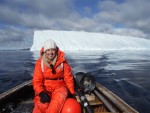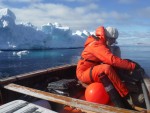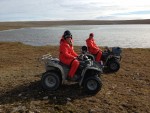Resolute Ice Island Study
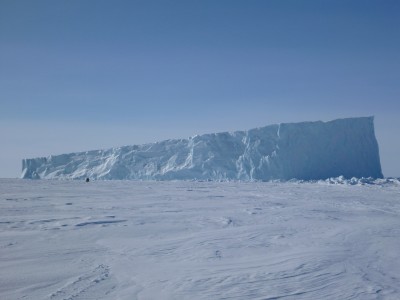
The iceberg in April 2013. Photo courtesy Jodi MacGregor (Polar Shelf).
After the calving of the Petermann Glacier in 2010, a large ice island (known to some as PII-Ab) wandered around Lancaster Sound in the summer and winter of 2011. As it went, pieces broke off and one of these ended up grounding close to the eastern end of Resolute Bay, Nunavut. This ice island fragment was several hundred metres in length and about 20 m tall with vertical sides. Over the years it was stuck there, it melted and came to look like a wedge, nearly drydock-shaped iceberg. Derek Mueller and Christine Michel decided to take the opportunity to study this iceberg since it was near the community of Resolute and access was relatively straightforward (as opposed to a drifting iceberg!). Together they co-supervised MSc student Melissa Nacke. Her main interest was to determine whether the iceberg influenced the surrounding ocean in any way (e.g., changing the physcial, chemical or biological nature of the waters). This type of study has been done several times in the Antarctic, where they have found that there is a huge boost in ocean productivity behind drifting icebergs (this is due to the release of nutrients, such as iron, that are found in low concentrations in Antarctic waters). Melissa wanted to see if there was a similar effect in the Arctic but wasn’t sure about this, since Arctic icebergs don’t have high concentrations of nutrients. She also wanted to see if she could detect meltwater coming from the iceberg using a CTD (conductivity-temperature-depth sensor) and water samples, which she analyzed for stable isotopic ratios. Melissa and her assistant worked with three guides from Resolute, NU who brought her out to the iceberg by boat for her sampling.
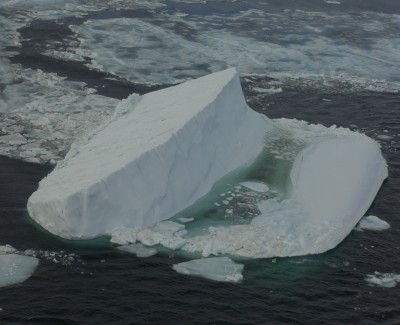
The iceberg in August 2014 viewed from the air. The change due to melting and calving over the past year is evident. The tilting revealed the underwater ram and made the iceberg look like a drydock berg with a pool of water in the middle. Photo courtesy Melissa Nacke.
Her analysis revealed that the influence of the iceberg on the surrounding marine environment was not detectable considering it was a small iceberg in a wide ocean! As well, the strong ocean currents in the area meant that there was a lot of mixing of iceberg meltwater into more saline ocean water so it was hard to detect. She did find a surprising amount of chlorophyll a, a pigment that represents algal biomass at a certain depth in the water column. These results are written up in her thesis entitled “Characterization of the coastal marine environment in the vicinity of a grounded iceberg, Canadian Arctic Archipelago” and we are working on publishing the results in the near future.
Support
We are grateful to Sam Brenner, Ross Pudluk, and Peter and Jeffrey Amarualik for field assistance. Murray Richardson, Andrea Niemi, Claude Belzile, and Sarah Zimmermann helped with field preparation and/or sample processing. This research was supported by NSERC, NSTP, ArcticNet, CFI, ERA, PCSP, Fisheries and Oceans Canada, First Air and the Arctic Circle.
- Melissa Nacke in front of the iceberg that she studied.
- Melissa working near her ice island.
-
Melissa and
on quads in Resolute.

